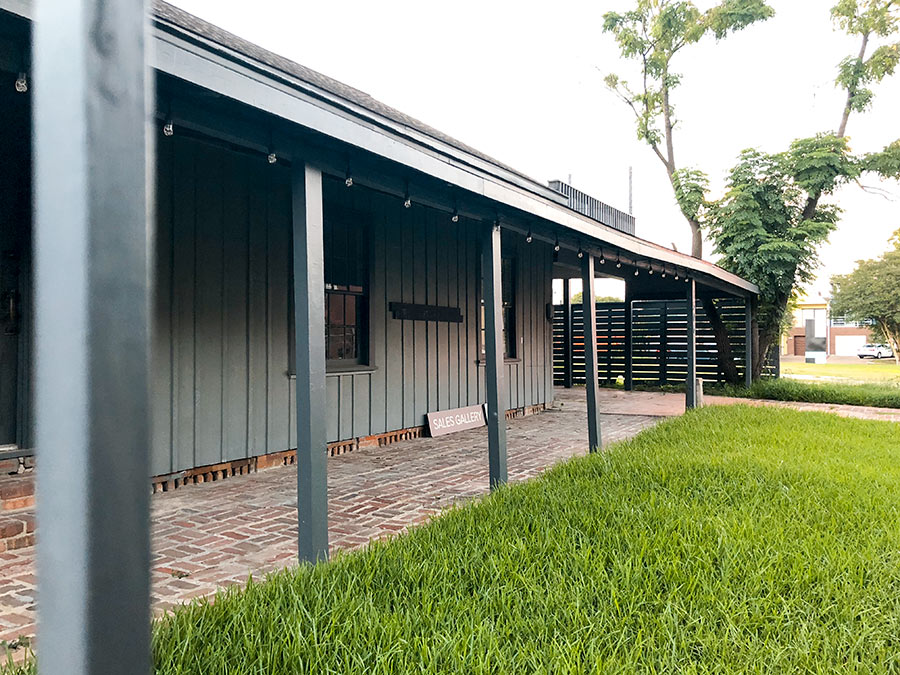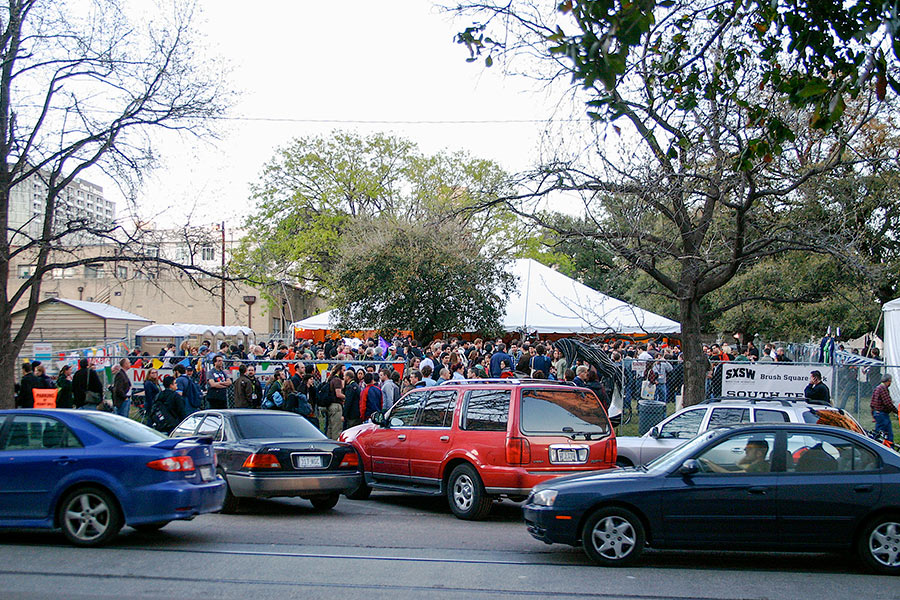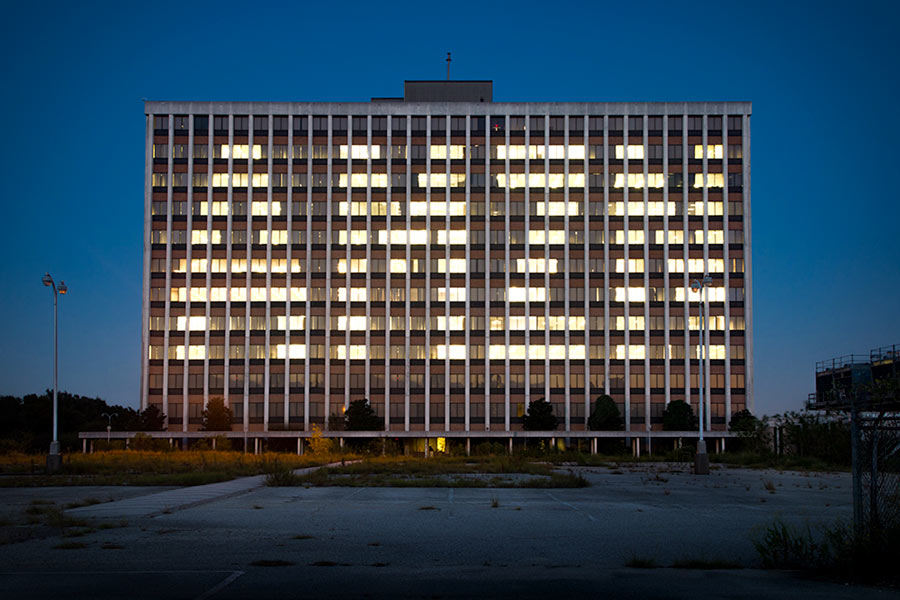STILL SELLING A LITTLE PLACE IN THE BIG CITY  “In 15 months of reporting on Houston’s suburbs and exurbs,” writes Mike Snyder, “I’ve heard this phrase again and again, usually uttered in a tone of wistful nostalgia. It’s often cited as a vital civic asset that’s at risk in rapidly growing cities such as Pearland that really were small towns within some residents’ lifetimes.” And it hits the print regularly too, he says: “A search for the phrase ‘small-town feel’ in the Chronicle‘s digital archives yielded 245 hits. Most were articles about real estate projects that used the phrase as a marketing tool. They carried headlines such as “Bay Oaks: Resort-style living with a small-town feel” and “Creekside Village will create a small-town feel.” [Houston Chronicle ($)] Photo: Stanford via Swamplot Flickr Pool
“In 15 months of reporting on Houston’s suburbs and exurbs,” writes Mike Snyder, “I’ve heard this phrase again and again, usually uttered in a tone of wistful nostalgia. It’s often cited as a vital civic asset that’s at risk in rapidly growing cities such as Pearland that really were small towns within some residents’ lifetimes.” And it hits the print regularly too, he says: “A search for the phrase ‘small-town feel’ in the Chronicle‘s digital archives yielded 245 hits. Most were articles about real estate projects that used the phrase as a marketing tool. They carried headlines such as “Bay Oaks: Resort-style living with a small-town feel” and “Creekside Village will create a small-town feel.” [Houston Chronicle ($)] Photo: Stanford via Swamplot Flickr Pool





It’s just that : a slick marketing ploy for a soul less exurb development..
The “small-town feel” of Creekside Village is not just a marketing tool, but an actual design concept that has been the basis for the Woodlands development for 40 years. The multiple “villages” in the Woodlands were designed to each have a centralized retail center plus parks, schools, churches, etc to simulate a small-town feel. Results have been mixed of course, but that was the concept.
I think “small-town feel” is part of the overall coded language for “appealing to red-state folks” – i.e., infrastructure will be car-centric and oriented toward child rearing (playgrounds, “good schools”), while maintaining low taxes.
I work out in Bay Oaks actually and there is totally a small town tight knitt community feeling. That HEB even though a great store, obliterated all the trees and the Reserves are taking away from that and making it regular old suburbia.
Any time that some company or government or movement attempts to wistfully market the aesthetic of a bygone era to a people of a different time and place — which is occurring constantly as an evolving process — they invariably get it wrong. A really good example of this is neoclassical architecture, basically an attempt at cuing on a Grecco-Roman political legacy that was viewed positively by contrast with European monarchies (although Hitler attempted a very similar aesthetic form to draw parallels with the Roman empire in contrast with western democracies); and what we got was the “Federal” subgenre, with lots of brilliant white exteriors. Problem is, actual Greek architecture and sculpture was very colorful. The aesthetic of all our government buildings are a travesty to history. None of this makes any sense, of course.
.
Nonsensical ad copy exists because it works. There are a lot of people that respond favorably to it. That doesn’t make the promulgators stupid and it doesn’t mean that this subset of consumers or the communities that they create are soulless. They are what they are, and nothing more and nothing less regardless of whether some other segment of society likes them or not. If ad copy doesn’t make any sense to you then guess what: you’re not in the target market. And if it seems to speak to you without actually informing you about the specific qualities of a product or its price then congratulations, you’re a chump like the rest of us and a participant in the human condition.
.
But…FWIW, here are my two cents on architecture. It should ignore what came before it except insofar as necessary to plug into legacy infrastructure, it should be highly functional and efficient, and it should be affordable. No consideration needs to be paid toward aesthetics in any way shape or form, for example by having windows. In a warm climate, a home should essentially be designed like an oversized commercial chest refrigerator for people to live in. Materials and technologies which are contemporary to our time and place should be used to the extent that they are cost effective. This would be humanity at its best, IMO, simply making the best of the circumstances they’re presented with rather than seeking meaning through fictives of beauty or community or a revered past or some such other nonsense.
@ TMR: There are a lot of people who would self-describe as *very* Democrat live in the Heights that resonate with the “small-town feel” ad copy, but they usually pay a substantially lower tax rate than the folks who would self-describe as *very* Republican and live in newer suburbs, especially the ones with a lot of community amenities. The latter category has HOA dues on top of that, and deed restrictions that mandate more maintenance and lawn care. Seems topsy-turvy, but I think that in most cases people seek solidarity with people that they perceive to be like them. Social identity is the name of the game; all other considerations involving facts and logic and what is practical are secondary.
@ TMR
Playgrounds, good schools and low taxes don’t appeal to blue-state folks?
Actually, don’t most suburbs who attempt the “small-town feel” have higher taxes than your run-of-the-mill isolated subdivision dropped by the side of the freeway?
Maybe if they actually developed within the town…
it’s houston, outside of downtown/midtown isn’t everything a slice of small town/surburban living in the city?
@TheNiche
We all may have different definitions of “small-town feel,” but to me the critical components are lowish population density, proximal small-scale retail and amenities (ie walkability) and community/neighbor engagement. Good architecture may promote these (inviting houses, front porches, etc) but is not necessarily a requirement. I would also consider the “small-town feel” to be alive and well in many actual small towns all across this country, so developers don’t exactly have to mine the bygone past for inspiration.
@TheNiche, @CV – the blue-state equivalent would be “community feel” or “close-knit neighborhood feel”. And by “lower taxes”, I’m speaking more about perception, which TheNiche rightly notes is the primary driver of these decisions. Take a poll of why people out in Bridgeland don’t want to live inside the loop, and I’d imagine “high city taxes” would be a common answer.
@ CV: I offer for your consideration two actual small towns. One is Brenham, which has a relatively intact and somewhat vibrant downtown area, a strong economy with many more and nicer stores than it would seem to deserve given its demography. There is a mix of older housing (including multifamily, which few people bother to notice), newer subdivisions which aren’t especially charming, and new McMansions built on platted or unplatted lots and acreage. Anybody who lives in any sort of home there can probably appreciate the small-town feel…even though in some respects they have big-city amenities. There are poorer neighborhoods, too, but none too exceptionally scary by Houston standards, even the mobile home parks. The other example is Navasota, to which the post-WW2 era has not been so kind; it is rather depressing to drive through Navasota or to spend much time there or to get to know it. Both communities are fairly insular though, and it’d be hard for an outsider to show up and feel accepted, even as a well-educated high-net-worth professional.
.
When people talk about small-town charm and seek it out in its authentic manifestation, they look at property listings in Brenham, not Navasota; but goodness knows that there are a whole lot more Navasotas out there than Brenhams. And that’s not to say that Brenham is a panacea for just anybody, either. Most people are forced to strike an unhappy compromise, wherever they end up. That’s how it is.
None of these places achieve anything like the feel of a real town because they abandon all of the design elements which actually create that feeling. There are no real walkable main streets with mom and pop stores lining the sidewalks. No town squares at the heart of real (albeit small) downtowns. It’s all just strip malls and McMansions along freeways and 6-lane collector roads.
If you want a small town feel you have to start with traditional pre-WW2 urban design.
@ Christian: It doesn’t matter what sort of aesthetic a town has; if there are people living there and going on about their business, it’s a real town. An example of a non-real town which occupies physical space would be the set of a movie, and even that or the Sim City city I built in middle school are real insofar as they exist conceptually in the mind.
I don’t think it’s primarily about design, although it can be. I think the “small town feel” that people are looking for comes from social connection with those that live around you. Design is an element of that; but so is longevity.
I’m sure that had there been a Swamplot in 1893, it’s commenters would have said similar things about the Heights or Montrose that commenters say today about the kinds of communities referenced in the article.
The small-town feel they talk about is usually orchestrated top-down from the start, like an open-air shopping mall, in contrast to an actual small town walkable corridor which ironically is probably more of a free-market type of situation with many landowners leasing to many small businesses. Sure, it is probably zoned, but Houston can have the same result with the right policy mix of setbacks, parking regulations, and maybe some type of form-based (maybe take it a step further and call it formula-based?) zoning…and if higher-quality tenants are desired, maybe make sure rents are higher by insisting on structural and environmental (including air quality, noise pollution, lighting, and maybe even landscaping) standards that are just that much farther above the norm.
@anon22 The irony of it is that most of the “small town” places that people reference pre-date zoning, which didn’t arrive in the US until 1916 and didn’t gain widespread acceptance until Euclid v Ambler in 1926. Zoning tends to favor the rigid division of uses and creates communities as banal as the local examples most of these comments criticize.
What people don’t realize is that real small towns are pretty run down places. Fort Bend County is a great place to see the difference between a “small town feeling suburb” and a real small town. Walk around Sugar Land Town Center first; which was developed essentially like any outdoor shopping center but meant to look and feel small town-like. Then head out to Richmond (or Rosenberg; it kind of doesn’t matter which) TX for the real thing. The difference is striking, and unlike most here I’m not sure I’d say the real thing is necessarily better.
Considerable debate defining “small town” but I think it comes down to what’s in the heart. Example in point. Cycled last Sunday, covering The Heights, Medical Center, Downtown, and Allen Parkway. The only car that honked in my vicinity had a bumper sticker from a church in … the Woodlands. The driver was impatient not with us cyclists but the truck in front of us who understandably paused on a right-hand turn at a red light downtown. The car promptly cut us off as soon as we cleared the light.